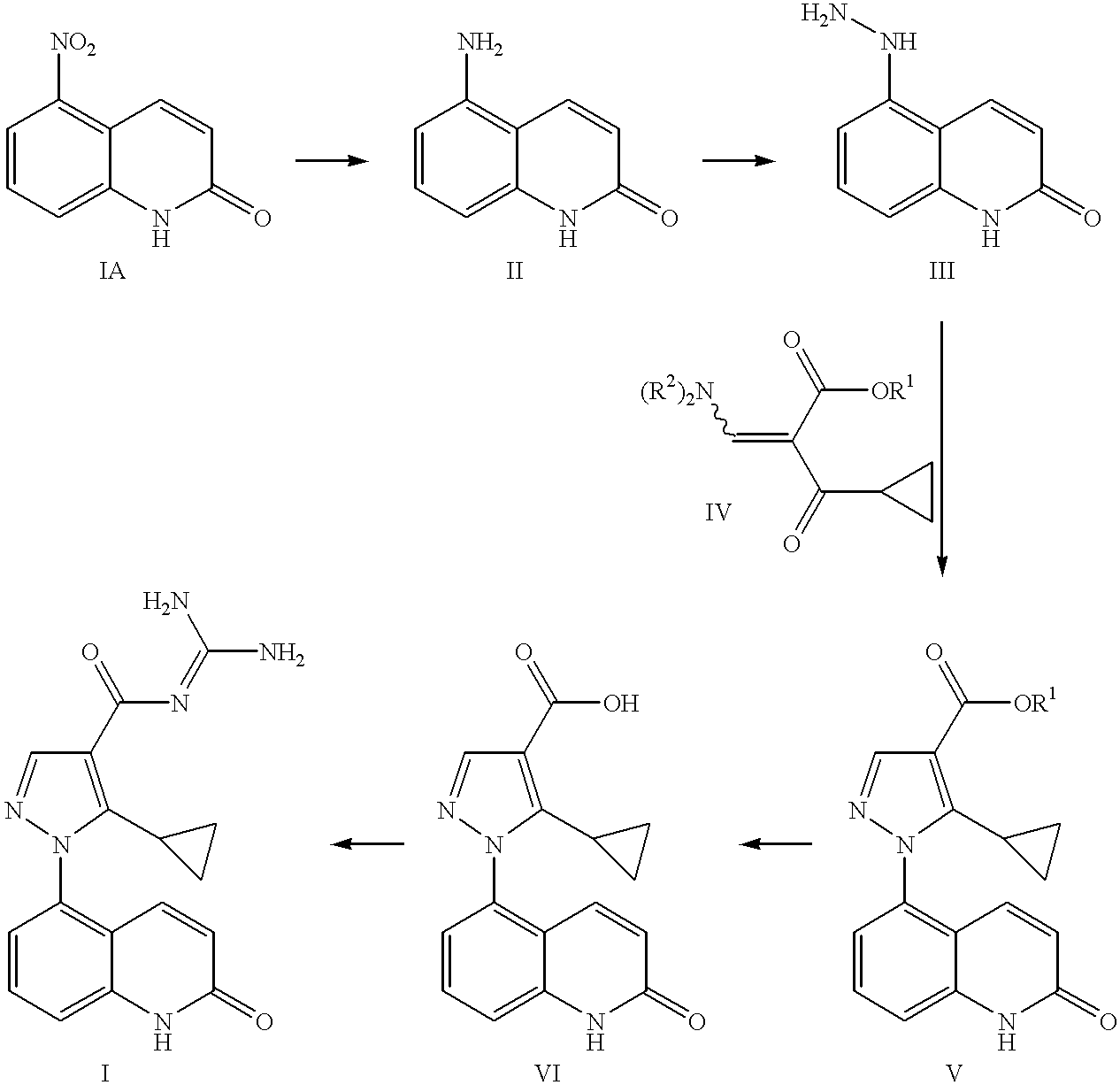Sodium-hydrogen exchanger type 1 inhibitor
a technology of sodium-hydrogen exchanger and inhibitor, which is applied in the direction of biocide, heterocyclic compound active ingredients, organic chemistry, etc., can solve the problems of sudden death, myocardial infarction or congestive heart failure, and achieve the effect of preventing perioperative myocardial ischemic injury
- Summary
- Abstract
- Description
- Claims
- Application Information
AI Technical Summary
Benefits of technology
Problems solved by technology
Method used
Image
Examples
example 1
5-Amino-2-guinolone Hydrochloride
A solution of the 5-nitro-2-quinolone (12.37 g, 65 mmol) (prepared as described in Capps, J. D.; Hamilton, C. S. J. Am. Chem. Soc. 1938, 60, 2104) in EtOH (176 mL) under a nitrogen atmosphere was treated with SnCl2.2H2O (73.4 g, 325 mmol). The heterogeneous reaction mixture was allowed to stir at 23° C. for 2 hours and heated at reflux for 2 hours. The resulting heterogeneous mixture was cooled to 23° C. and filtered. The solid material was triturated in HCl (1 M aqueous, 78 mL, 78 mmol) at reflux for 1 hour, cooled to 23° C., and filtered to afford 10.08 g of the desired product (78% yield).
1H NMR (400 MHz, DMSO-d6) δ 6.42 (d, J=10, 1H), 6.71 (d, J=7.6, 1H), 6.81 (d, J=8, 1H), 7.27 (d, J=8, 1H), 8.04 (d, J=10, 1H), 11.71 (bs, 1H).
APCIMS 161 [M+1]+
example 2
5-Hydrazino-2-guinolone Hydrochloride
A solution of 5-amino-2-quinolone hydrochloride (10.08 g, 51.2 mmol) in HCl (concentrated, 42.7 mL) and H2O (18.2 mL) at 0° C. was treated dropwise with a solution of NaNO2 (3.53 g, 51.2 mmol) in H2O (26.4 mL) while maintaining the temperature below 5° C. The resulting red suspension was allowed to stir at 0° C. for 1 hour.
In a separate three neck round bottom flask equipped with a mechanical stirrer, a slurry of SnCl2.2H2O (25.41 g, 112.6 mmol) in HCl (concentrated, 34.2 mL) and H2O (93.9 mL) was cooled to 0° C. The suspension was treated dropwise with the red diazonium salt suspension prepared above, while maintaining the temperature below 5° C. The reaction mixture was warmed to 23° C. and allowed to stir for 3 hours. The resulting suspension was filtered. The collected solid was triturated with HCl (1 M aqueous, 61.4 mL, 61.4 mmol) at 23° C. for 30 minutes. The solid was collected by filtration to afford 7.88 g of the desired product (73% yie...
example 3
Methyl 5-cyclopropyl-1-(2-guinolon-5-yl)-1H-pyrazole-4-carboxylate
A solution of methyl 3-cyclopropyl-2-(dimethylaminomethylene)-3-oxopropanoate (7.85 g, 39.8 mmol) in EtOH (257 mL) was treated under a nitrogen atmosphere with triethylamine (7.77 mL, 55.8 mmol), followed by 5-hydrazino-2-quinolone hydrochloride (7.88 g, 37.2 mmol). The resulting heterogeneous reaction mixture was heated at reflux for 4 hours and cooled to 23° C. A pale yellow solid precipitated out and was collected by filtration to afford 5.06 g of the desired product (44% yield).
1H NMR (300 MHz, DMSO-d6) δ 0.59-0.73 (m, 4H), 1.87 (m, 1H), 3.79 (s, 1H), 6.54 (d, J=10, 1H), 7.17 (d, J=10, 1H), 7.34 (d, J=7.5, 1H), 7.49 (d, J=8, 1H), 7.66 (t, J=8, 1H), 8.08 (s, 1H), 12.10 (bs, 1H).
APCIMS 310 [M+1]+
PUM
 Login to View More
Login to View More Abstract
Description
Claims
Application Information
 Login to View More
Login to View More - R&D
- Intellectual Property
- Life Sciences
- Materials
- Tech Scout
- Unparalleled Data Quality
- Higher Quality Content
- 60% Fewer Hallucinations
Browse by: Latest US Patents, China's latest patents, Technical Efficacy Thesaurus, Application Domain, Technology Topic, Popular Technical Reports.
© 2025 PatSnap. All rights reserved.Legal|Privacy policy|Modern Slavery Act Transparency Statement|Sitemap|About US| Contact US: help@patsnap.com



